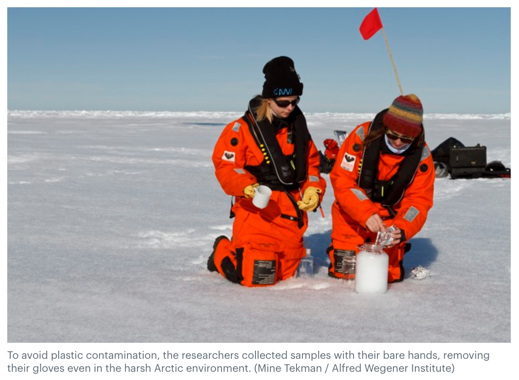By Tyler Drden: A new study has revealed that high levels of microplastics have been detected in some of the most remote regions of the world.
The discovery, published in the journal Science Advances, is the first international study on microplastics in snow, conducted by the Alfred Wegener Institute in Germany.
 Melanie Bergmann, the lead scientist, and her team of researchers found microplastics from the Alps to the Arctic contained high levels of the plastic fragment, raises questions about the environmental and health implications of potential exposure to airborne plastics.
Melanie Bergmann, the lead scientist, and her team of researchers found microplastics from the Alps to the Arctic contained high levels of the plastic fragment, raises questions about the environmental and health implications of potential exposure to airborne plastics.
I was really astonished concerning the high concentrations," said co-author Gunnar Gerdts, a marine microbiologist at the Alfred Wegener Institute.
Bergmann explains that microplastics come from industrial economies where rubber and paints are used. The tiny fragments end up in the sea, where they're broken down by waves and ultraviolet radiation, before absorbing into the atmosphere.
From there, the plastic particles are captured from the air during cloud development, can drift across the Earth via jet streams. At some point, the particles act as a nucleus around which supercooled droplets can condense, and travel to Earth as snow.
Bergmann noted how the scientific community was only in its infancy of examining the process of how microplastics get sucked up into the atmosphere then scattered around the world in some form of precipitation. She said, there's an "urgent need for research on human and animal health effects focusing on airborne microplastics."
Bergmann identified a wide range of different plastics in the samples, from varnishes and paints used to coat structures, ships, automobiles, and oil rigs; rubber particles from car tires; fibers from synthetic clothing; and mass-produced synthetics, such as polyethylene, PVC, polystyrene, and polycarbonate.
More research on the full environmental and health impacts of airborne microplastics still need to be done, but preliminary results suggest a silent plastic apocalypse has infected Earth.
Edited by AA
Source
The discovery, published in the journal Science Advances, is the first international study on microplastics in snow, conducted by the Alfred Wegener Institute in Germany.
 Melanie Bergmann, the lead scientist, and her team of researchers found microplastics from the Alps to the Arctic contained high levels of the plastic fragment, raises questions about the environmental and health implications of potential exposure to airborne plastics.
Melanie Bergmann, the lead scientist, and her team of researchers found microplastics from the Alps to the Arctic contained high levels of the plastic fragment, raises questions about the environmental and health implications of potential exposure to airborne plastics.I was really astonished concerning the high concentrations," said co-author Gunnar Gerdts, a marine microbiologist at the Alfred Wegener Institute.
Bergmann explains that microplastics come from industrial economies where rubber and paints are used. The tiny fragments end up in the sea, where they're broken down by waves and ultraviolet radiation, before absorbing into the atmosphere.
From there, the plastic particles are captured from the air during cloud development, can drift across the Earth via jet streams. At some point, the particles act as a nucleus around which supercooled droplets can condense, and travel to Earth as snow.
"Although there is a huge surge of research into the environmental impact of plastics, there is still so much that we do not know," said Bergmann.
Bergmann noted how the scientific community was only in its infancy of examining the process of how microplastics get sucked up into the atmosphere then scattered around the world in some form of precipitation. She said, there's an "urgent need for research on human and animal health effects focusing on airborne microplastics."
"Once we have determined that large quantities of microplastic can also be transported by the air, it naturally raises the question as to whether and how much plastic we are inhaling," she said, "raising the question of whether breathing in these particles might increase the risk of suffering respiratory and lung diseases."The study's sampling sites were on icebergs in the Arctic between Greenland and Svalbard averaged 1,760 particles per liter of melted snow, with one approaching 14,600 particles per liter. The highest concentration of all, 154,000 particles per liter found in new snow from the Bavarian Alps.
Bergmann identified a wide range of different plastics in the samples, from varnishes and paints used to coat structures, ships, automobiles, and oil rigs; rubber particles from car tires; fibers from synthetic clothing; and mass-produced synthetics, such as polyethylene, PVC, polystyrene, and polycarbonate.
More research on the full environmental and health impacts of airborne microplastics still need to be done, but preliminary results suggest a silent plastic apocalypse has infected Earth.
Edited by AA
Source



No comments:
Post a Comment